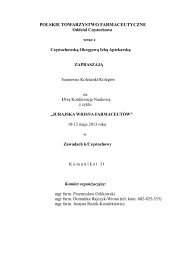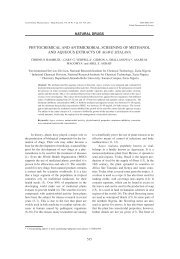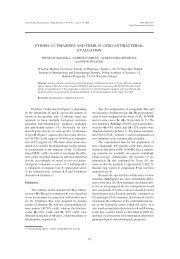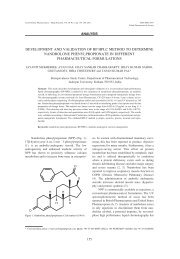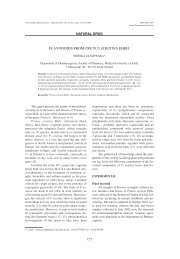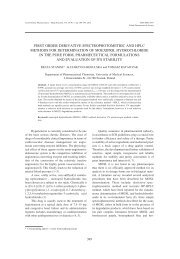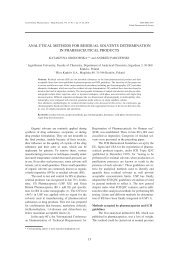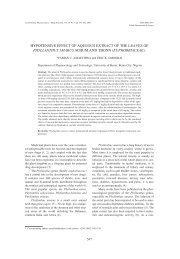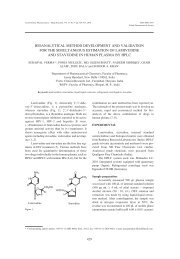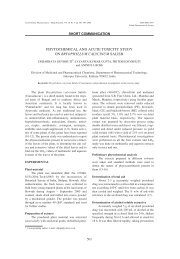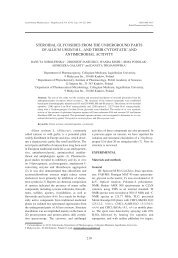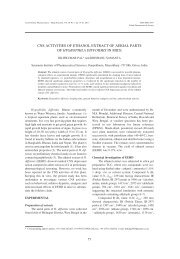CYTOTOXIC EFFECT OF SOME MEDICINAL PLANTS FROM ...
CYTOTOXIC EFFECT OF SOME MEDICINAL PLANTS FROM ...
CYTOTOXIC EFFECT OF SOME MEDICINAL PLANTS FROM ...
Create successful ePaper yourself
Turn your PDF publications into a flip-book with our unique Google optimized e-Paper software.
264 MAGDALENA WEGIERA et al.<br />
cyanus, Tanacetum vulgare and Tragopogon pratensis<br />
against J-45.01 human T cell leukemia cell line.<br />
MATERIALS AND METHODS<br />
Plant material<br />
The different plant organs from selected<br />
species of the Asteraceae family were used in this<br />
study: roots and herbs of Arctium lappa (RAc, HAc),<br />
roots and herbs of Artemisia absinthium (RAt, HAt),<br />
herbs and inflorescents of Centaurea cyanus (HCe<br />
and ICe) and roots, herbs and inflorescents of<br />
Calendula officinalis (RCa, HCa and ICa),<br />
Tanacetum vulgare (RTa, HTa and ITa) and<br />
Tragopogon pratensis (RTr, HTr and ITr). These<br />
abbreviations are consistently used in the text. The<br />
plant samples were collected from natural habitat at<br />
the end of June (herbs), July (inflorescents) and in<br />
the September (roots) of 2009, near Lublin (Poland).<br />
Voucher specimens were deposited at the Chair and<br />
Department of Pharmaceutical Botany, of the<br />
Medical University of Lublin (Poland).<br />
Plant extraction<br />
One gram of air-dried and powdered plant<br />
material was extracted with 35 mL of 70% aqueous<br />
methanol solution. The extraction was carried out<br />
for 1 h in boiling water bath using a cooler. The<br />
received extract was cooled down to room temperature<br />
and filtered to 100 mL volumetric flask.<br />
Then, the material remaining was extracted again<br />
with 70% aq. methanol solution in the same conditions<br />
as before. After filtering, the obtained mixtures<br />
were combined in volumetric flask and filled<br />
to 100 mL with distilled water (extract A). Extract<br />
A was used for phytochemical analysis to determine<br />
the total polyphenol content. A part of the<br />
extract A (50 mL) was evaporated and condensed<br />
in liquid nitrogen to dry residue (extract B, subject<br />
to biological assay).<br />
Cell lines and culture medium<br />
The J-45.01 cell line (Jurkat; human acute T<br />
leukemia cell line from ECACC, cat. no. 88042803)<br />
was used in this work. It was cultured by ECACC<br />
protocol at the concentration of 5 ◊ 10 5 cells/mL. All<br />
cultures were grown in an incubator (Biotech) in<br />
humifidied atmosphere of 5% CO 2 , for 24 h at 37 O C.<br />
The growing medium consisted of: RPMI 1640<br />
medium (Sigma, St. Louis, USA), 10% heat inactivated<br />
fetal bovine serum (Sigma, St. Louis, USA), 2<br />
mM L-glutamine and antibiotics: penicillin (100<br />
U/mL), streptomycin (100 µM/mL) and amphotericin<br />
B (2.5 µg/mL) (Gibco, Carlsbad, USA).<br />
Trypan blue assay<br />
The J-45.01 cells in concentration 5 ◊ 10 5<br />
cells/mL were stimulated in vitro with various concentrations<br />
of ethanol extracts (0.04ñ1.0 mg/mL).<br />
The cells were incubated for 24 h at 37 O C in humidified<br />
atmosphere of 5% CO 2 . At the end of this period,<br />
the medium from each plate was removed by<br />
aspiration. Then, 10 µL suspension of the cells were<br />
incubated for 5 min with 10 µL of 0.4% trypan blue<br />
solution (Sigma). Thereafter, the presence of nonviable<br />
cells, which were dark blue and viable cells,<br />
which excluded the dye, was analyzed in Olympus<br />
BX41 microscope. The study was an average of 10<br />
randomly selected fields in the preparation, so that<br />
the sum of all cells was not less than 200. The percentage<br />
of viable cells in controls was higher than<br />
95%. The IC 50 doses (concentrations at which cell<br />
viability was 50%) were set by means of MS Excel<br />
spreadsheet, using data received from tree independent<br />
test.<br />
Annexin V assay<br />
The Annexin V assay (Pharmingen, San Diego,<br />
USA) was used to estimate the number of cells in<br />
the early and late stages of apoptosis (according of<br />
manufacturer protocol). The 24-h cell cultures were<br />
centrifuged at 800 rpm for 10 min at room temperature<br />
and the culture medium was removed. Then,<br />
they were incubated for 10 min in the buffer comprising<br />
10 mM Hepes [N-(2-hydroxyethyl)piperazine-Ní-(2-ethanesulfonic<br />
acid) hemisodium<br />
salt]/NaOH, pH 7.4, 140 mM NaCl, 2.5 mM CaCl 2 ,<br />
annexin V labelled with 0.65 µg/mL of FITC and<br />
propidium iodide (12 µg/mL). Thereafter, samples<br />
were analyzed by an Olympus BX41 light and fluorescence<br />
microscope for the presence of viable cells<br />
(annexin V ñ /PI ñ ); early apoptotic (annexin V + /PI ñ )<br />
and late apoptotic/necrotic cells (annexin V + /PI + ).<br />
Fluorescein isothiocyanate-labeled annexin V could<br />
bind the outer membranes of apoptotic cells and discriminate<br />
apoptotic cells in the early stage from<br />
necrotic cells when used with propidium iodide. The<br />
extracts mediated apoptosis was expressed as the<br />
percentage of apoptotic cells/total cells. Cell morphology<br />
using a BX41 Olympus light and fluorescence<br />
microscope was also examined. Data were<br />
processed according to the MultiScan software. All<br />
the samples were analyzed at the concentrations<br />
close to IC 50 values or at the concentration with 50%<br />
of living cells in breeding.<br />
Determination of total polyphenols<br />
The determination of a total polyphenol compounds<br />
in the examined species was carried out



